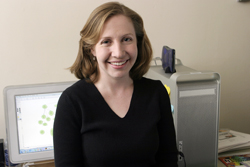Faculty News
Ann Rivet, Science Education, and Colleague Awarded $982,080 NSF Grant
When it comes to covering foundational science concepts, teachers of biology, physics and chemistry have a wide range of in-class activities from which to choose. For example, they can guide students through any number of controlled experiments, such as observing the continuous growth cycle of a plant; measuring the terminal velocity of a ball traveling in glycerol; or analyzing the synthesis reaction of iron with sulfur. Earth science teachers, however, don’t have it so easy; within the limits of a 37-minute class, they have to demonstrate massive earth processes like hurricanes, tectonic shifts and water currents–phenomena that span far beyond the classroom, in terms of both space and time.
“The challenge,” says TC’s Ann Rivet, Assistant Professor of Science Education, “is that you can’t fit the earth into a classroom.” To address this issue, earth science teachers have relied on table-top models and experiments to simulate such processes. Recently, Rivet, along with Kim Anne Kastens, Senior Research Scientist at Columbia University ’s Lamont-Doherty Earth Observatory in Palisades , New York
Their hypothesis is that students can’t always translate what they learn with a classroom model into knowledge about Earth systems. The pair have begun studying how models are used in 8th- and 9th-grade Earth Studies classrooms in Rockland and Westchester counties. They will map the “analogical linkages” between the models and the full-scale systems, to see how well students understand the relationships. “Then,” Kastens says, “we have a couple of ideas about how to improve the use of the models so as to make the linkage between the models and the Earth systems stronger.”
The three-year project, “Collaborative Research: Bridging between Tabletop Models and the Earth System,” will result in peer-reviewed papers and possibly professional teaching models, Rivet says.
Published Monday, Jan. 11, 2010
